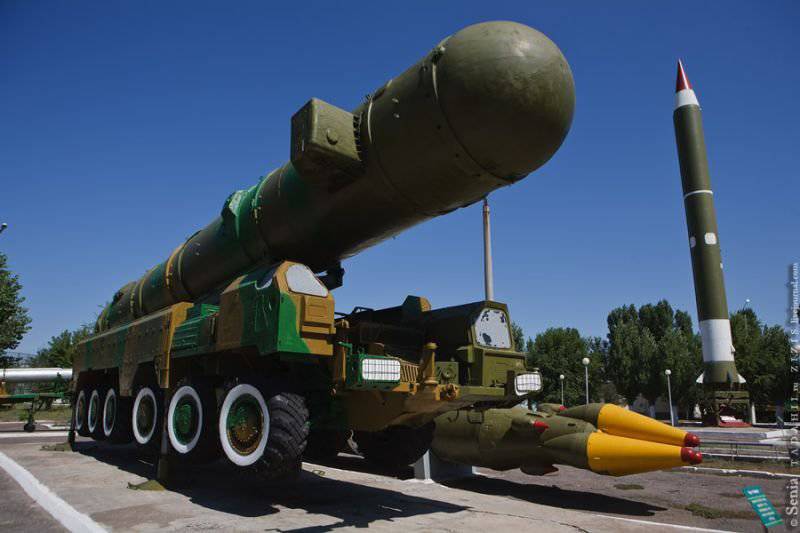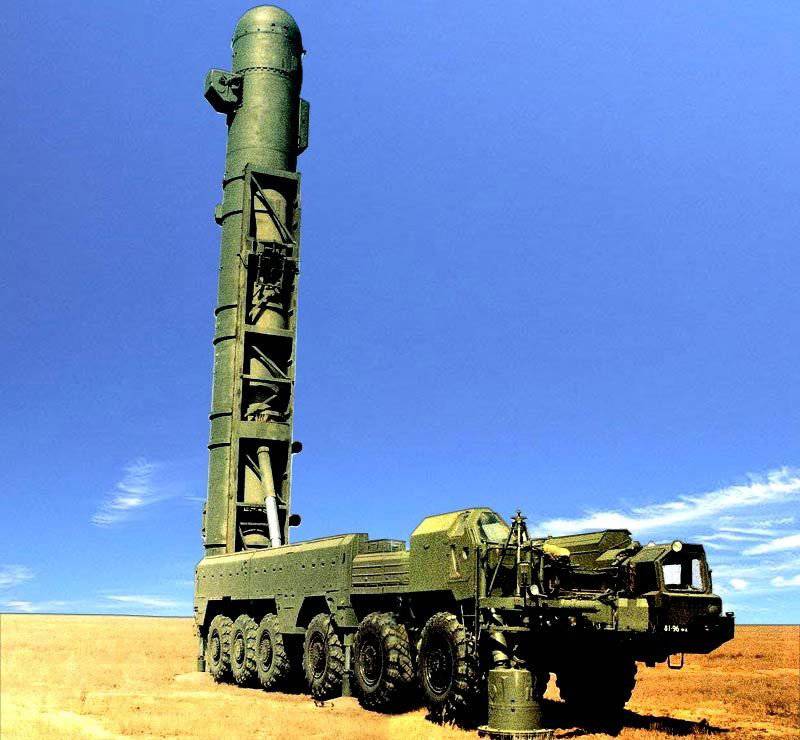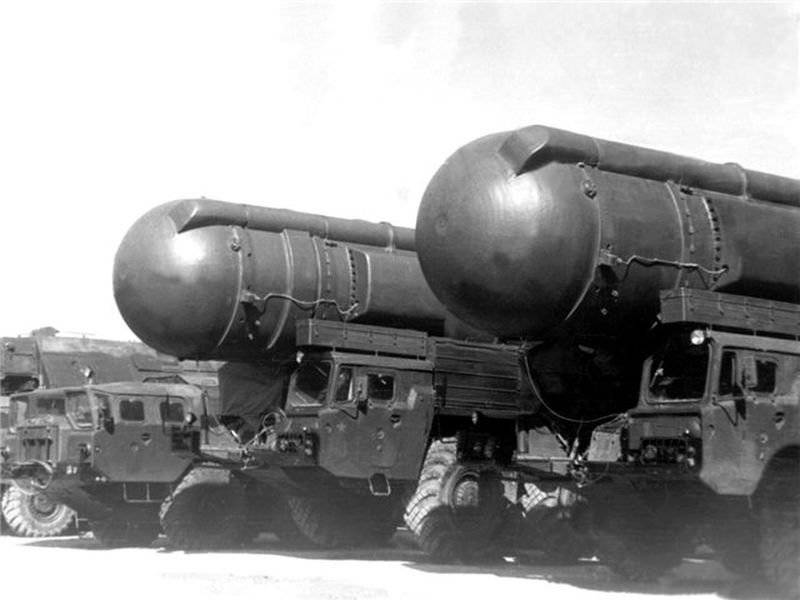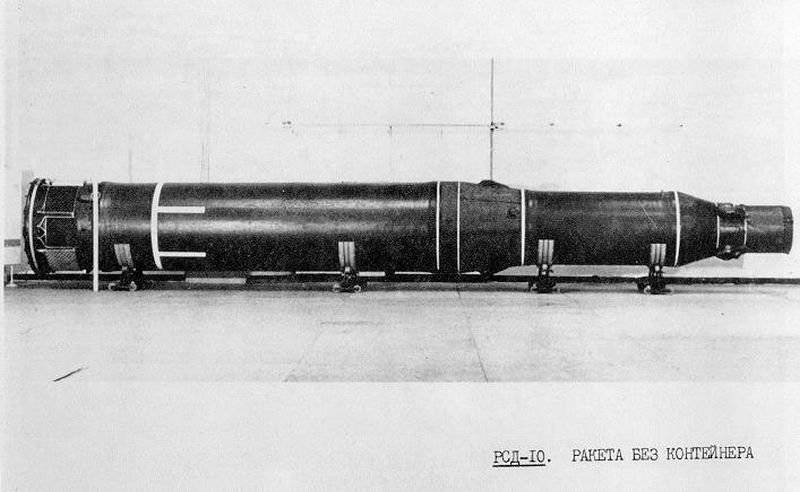SS-20 - "Pioneer", which was always ready
- throttle cut-off control unit for the second stage;
- connecting compartment;
- split head.

The end of the practical factory work off of all the developed solutions was marked by flight tests of the RSD-10 at the Kapustin Yar test site at the end of September 1974. The designers took about 1.5 year to eliminate the identified problems, and go through a full program of state tests. In mid-March 1976, the state committee signs the acceptance certificate for the RSD-10 and the Pioneer complex is admitted to the Strategic Missile Forces of the Soviet Union. The complex replaced the P-14 missiles in service with the USSR Armed Forces, this caused a well-known alarm in foreign countries and was reflected in the name of the complex - SS-20 or “European Thunderstorm”.
In early August, 1979, a test rocket with improved characteristics called "15ЖХNNXX" entered the test. Tests were held at the same test site as 53ЖX15. More than a year tests lasted and comments were eliminated. In mid-December, 45, the improved complex under the designation "Pioneer UTTH" enters the Strategic Missile Forces. The main differences of the rocket 1980Ж15 - improved control system and unit-instrument unit. Improvements allowed to increase accuracy of hit to 53 meters. Replacing engines increased the radius of BB breeding and increased the range of the complex to 450 thousands of kilometers. At 5.5, the Soviet Union had 1987 650Ж15 and 45Ж15 missiles. All of them were intended to strike back at various sites in Europe, the Middle East, the United States and Asia. RSD-53 and "Pioneer UTTH" were in service until 10 year. According to the INF Treaty, since 1991, the complexes are beginning to be eliminated. First, the missiles were destroyed by launching missiles. It is worth noting that the complexes showed during liquidation launches that all characteristics correspond to factory parameters. The following complexes were eliminated by blasting missiles directly in factory containers, the chassis of the complexes after dismantling, and were sent to the storage areas of automotive vehicles. By the middle of 1991, all the missiles were destroyed. Several units of both rockets and complexes were left as exhibits for domestic and foreign museums of military equipment.
The composition and design of the complexes "Pioneer"
The standard composition of the complex includes the following components:
- ballistic missile 15ЖХNNUMX or 53Ж15;
- PU;
- vehicle for loading missiles;

The rocket consists of two marching stages, an aggregate-instrument block and a head section. Between themselves, they are connected with docking compartments. The control of the 1 th stage consists of a body made of fiberglass and a solid fuel charge, bottom covers and a nozzle, and a nozzle. In the lower section there are engines for braking and equipment for steering gears. To correct the trajectory and flight control, 8 aerodynamic and gas dynamic steering arrays were used. The control of the 2-th stage repeated the basic design of the control of the 1-th stage, but the flight control was carried out according to a different principle. To control the yaw and pitch angles, a method of blowing gas from a gas generator into a part of the nozzle, called supercritical, was used. To control the angles of the roll, the method of running gas on a special device was used. The two-stage propulsion systems used a system to cut off traction. The engine is disconnected by opening a dozen openings in the front of the combustion chamber. The pressure in the chamber drops, and the solid fuel stops burning.
The missile control system is developed by designers under the leadership of Academician N. Pilubin. SU missiles were built with the use of onboard VM, which ensured the achievement of the declared factory characteristics, carrying out routine maintenance and inspections.
All important control units had redundant backup units. This increased the reliability of the control system. All equipment is in a sealed compartment. The head of the split type MIRV with three BB. Power of one BB -150 kilotons. Each combat unit was individually guided to the selected target. Step for breeding BB had its own control system and remote control on solid fuel. The head part is made without aerodynamic fairing, BB to improve the aerodynamic characteristics of the flight stage was located at an angle to the axis of the rocket.

Variants of manufacturing the “Pioneer” MS missiles:
- Mod 1. MS monoblock type. Application range up to 5 thousands of kilometers;
- Mod 2. MS of the separable type. Three BB with IN. Application range up to 5.5 thousands of kilometers;
- Mod 3. MS monoblock type. Power BB- 50 kilotons. Range of application to 7.4 thousands of kilometers. Not commercially available.
The mode of operation meant placing the rocket in a hermetically sealed TPK. The container was placed on a self-propelled PU. Automobile six-axle chassis PU received from the MAZ-547. In addition to TPK with a rocket, there are also equipment for conducting technical control and launching of a rocket on the chassis. Despite its weight - about 80 tons, the speed of the SPU was quite solid - up to 40 km / h, could make movements on any roads, overcome the meter ford and rise to 15 degrees. Turning radius 21 meter. The launch production was carried out from the prepared positions of the “Krona” type or equipped field positions. PU hung on jacks and leveling. The powder pressure accumulator was used to eject a missile from the TLC during launch production. At a given height, the main engine of the 1 th stage was turned on. “Krona” is a metal structure in order to exclude permanent reconnaissance of the movement of the complexes. It has a through gate, which makes it possible to easily maneuver large-sized military equipment. Electric furnaces are located next to the Krona's internal walls, which prevent the possibility of thermal detection inside the Krona. When launching a rocket from the “Krona” with the help of squibs, metal sheets are thrown from the roof. In the educated "slot" raise the container and produce shooting. On the route of the complex of such facilities to mislead a tracking enemy was enough.

The main characteristics of the RSD-10:
- used rocket 15Ж45;
- application range from 600 to 5 thousands of kilometers;
- KVO 0.55 kilometer;
- the mass of MS from the version from 1500 to 1740 kilograms;
- length 15Ж45 16.49 meter;
- length 15Ж45 in TPK 19.32 meter;
- diameter 179 centimeters;
- Mass 15Ж45 37 tons;
- curb weight TPN 42.7 tons;
- length, height and width of PU by three meters;
- drive for lifting TPK - hydraulic type;
- crew of three people.
Additional Information
According to well-known US intelligence, the 1986 had a deployed launcher on the 441 year. According to official data, according to the agreement on the elimination of INF on the 1987 year between the Union and the States, the Union had 405 deployed PU and 245 missiles stored in arsenals and warehouses. During its operation with rockets there was not a single destruction or a single accident. For all the time, 190 missile launches were made, the overall probability of hitting the target is 98 percent.
Information